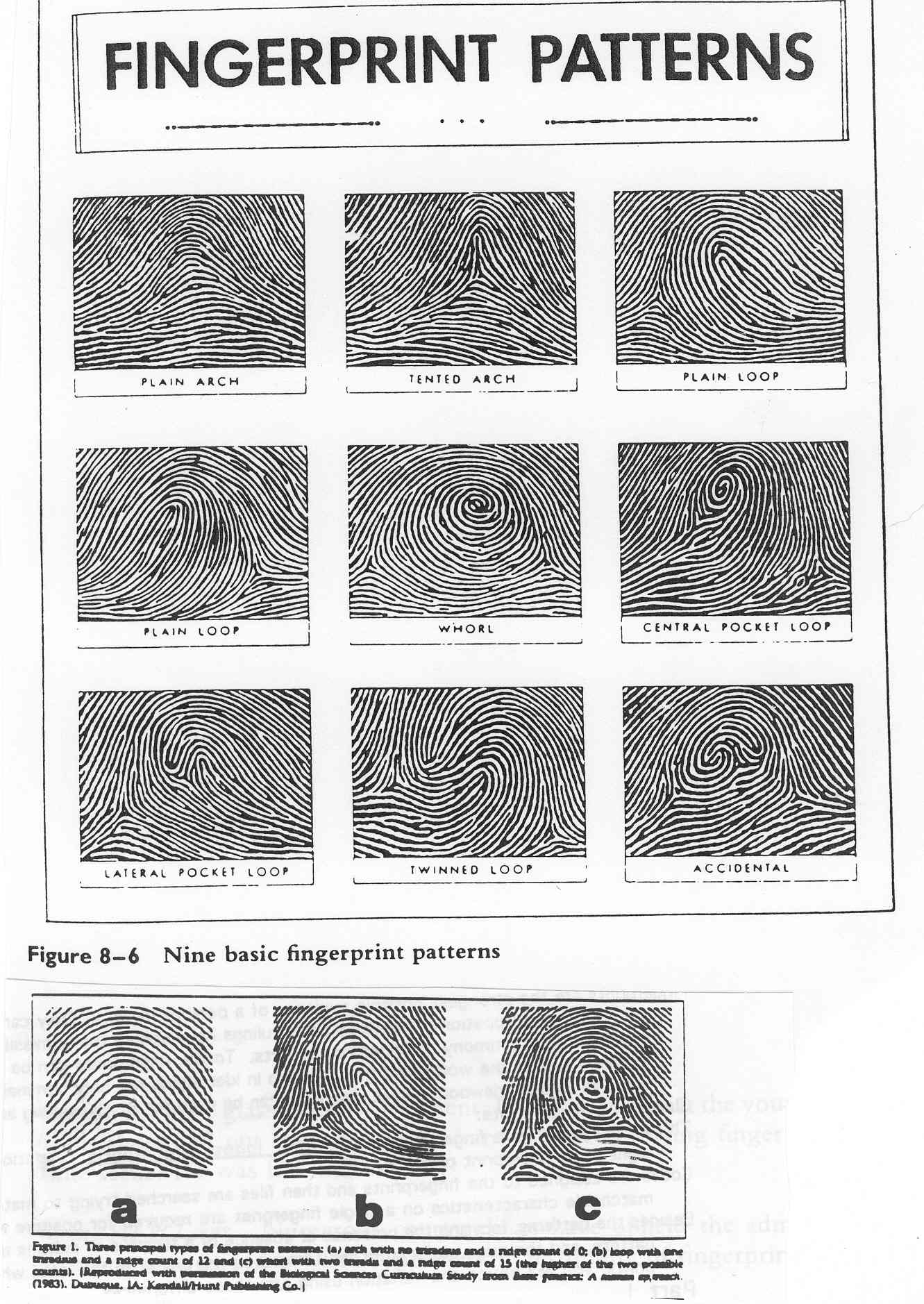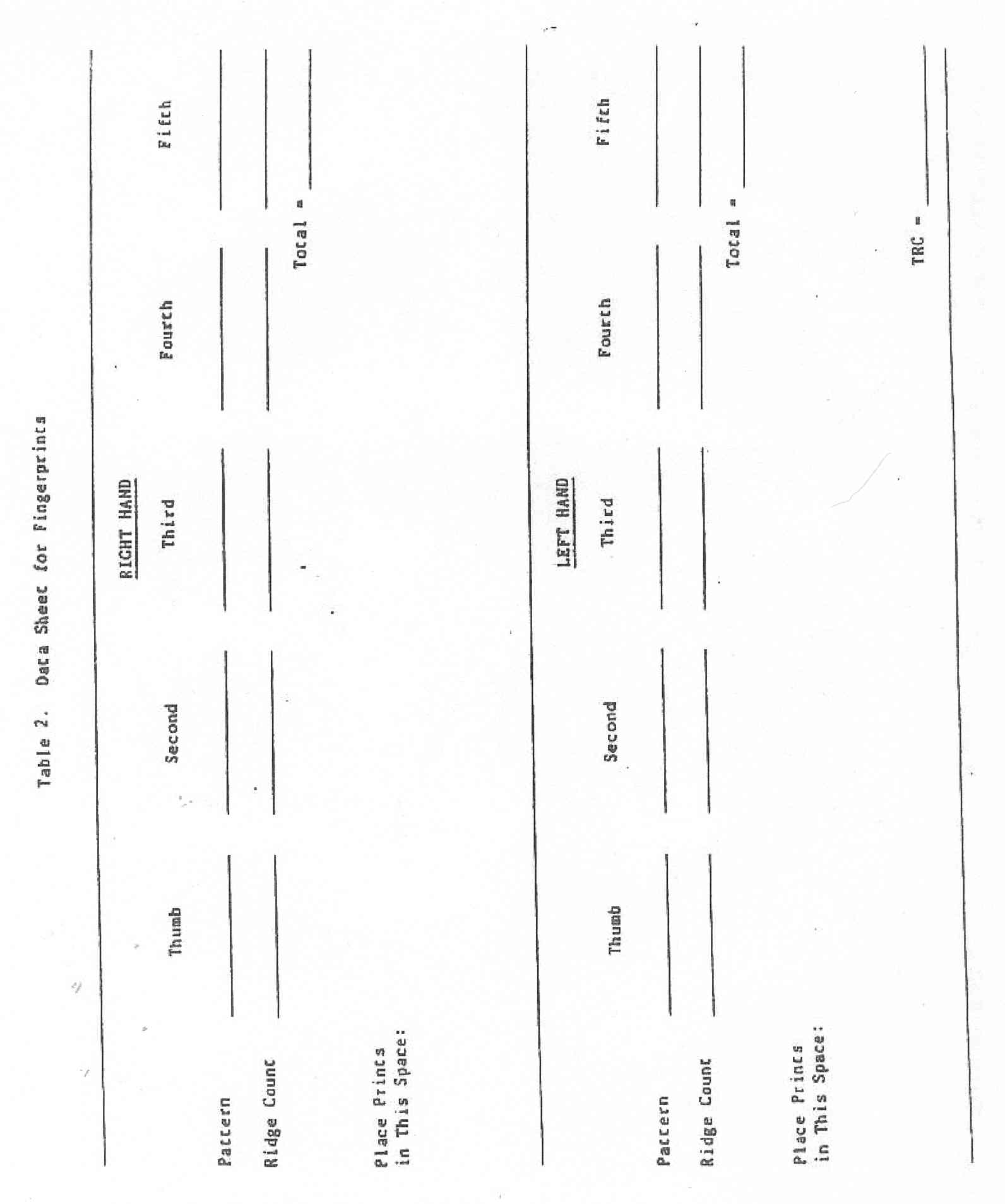
FINGERPRINTS
http://onin.com/iaifp/
Is fingerprint identification
a science.... and can tiny fragments of finger or palm prints be reliably
identified in accordance with modern legal and scientific guidelines?
Yes. It is scientific.
Fingerprints have been collected,
observed and tested as a means of unique identification of persons for more than
100 years.
Scientists have proven the validity of fingerprint identification,
including tiny fragments, in courts throughout the world for many years.
The two basic ideas scientists believe about fingerprints are:
· Fingerprints never change. Small ridges form on a person's hands and feet before they are born and do not change for as long as the person lives.
·
No two fingerprints are alike. The ridges on the hands and feet of
all persons have three characteristics (ridge endings, birfurcations and dots)
which appear in combinations that are never repeated on the hands or feet of any
two persons. A ridge ending is simply the end of a ridge. A bifurcation is
a Y-shaped split of one ridge into two. A dot is a very short ridge that
looks like a "dot".
The basic fundamentals in the science of
fingerprint identification are permanence and individuality.
Permanence:
Fingerprint ridges are formed during the third to fourth month of fetal
development. These ridges consist of individual characteristics called
ridge endings, bifurcations, dots and many ridge shape variances.
The unit relationship of individual characteristics does not naturally change
throughout life... until decomposition after death. After formation, an
infant's growing fingerprint ridges are much like drawing a face on a balloon
with a ball-point pen and then inflating it to see the same face expand
uniformly in all directions. Unnatural changes to fingerprint ridges
include deep cuts or injuries penetrating all layers of the epidermis and some
diseases such as leprosy.
Permanent scars, disease damage, and temporary changes such
as paper cuts appear as jagged edges and sometimes "puckered" ridge
detail in opposition to smooth flowing natural formations. Warts can come
and go, but generally push apart an area of friction ridges and can disappear
completely when the wart is gone because they are not a part of the friction
ridge structure. Look at a wart with a magnifying glass and you will
notice that the friction ridges "surround" the wart. Senile
atrophy of friction skin due to old age causes the ridges to often almost
flatten, causing fingerprints with many creases (creases are also unique but not
always permanent) and poorly defined ridges. Oddly, newborn infants
also often have more creases than clearly defined ridge detail in their barefoot
prints. The creases are unique, but change relatively rapidly and often
disappear as the infant grows. The best chance of seeing friction skin
ridges on newborn infant footprints is to look carefully with a magnifying glass
on and near the big toe.
Individuality: In the over 140 years that fingerprints
have been routinely compared world wide, no two areas of friction skin on any
two persons (including identical twins) have been found to contain the same
individual characteristics in the same unit relationship. This means that
in general, any area of friction skin that you can cover with a dime (and often
with just a pencil eraser) on your fingers, palms, or soles of your feet will
contain sufficient individual characteristics in a unique unit relationship to
enable positive identification to the absolute exclusion of any other person on
earth. Recent studies comparing the fingerprints of cloned monkeys showed
that they, just like identical twin humans, have completely different
fingerprints. When doctors state that twins have the same fingerprints,
they are referring to the class characteristics of the general ridge flow,
called the fingerprint pattern. These loop, arch and whorl ridge flow
patterns have nothing to do with the individual characteristics used to
positively identify persons. Before modern computerized systems,
fingerprint classification was essential to enable manual filing and retrieval
of fingerprints in large repositories.
For many years experts testified that no two fingerprints in
the hundreds of millions of fingerprint cards on file in America had ever been
found to be alike. This was misleading in that large fingerprint files
were for the first 110 years of police usage separated into small file
categories by class characteristics such as:
·
sex
·
age
·
presence
of scars
·
presence
of whorl, loop and arch formations in various fingers
·
ridge counts and tracings between different pattern focal points (deltas
and cores)
Thus, for example, at the FBI's former Identification
Division with over 200 million fingerprint cards, no individual card and no
individual fingerprint was ever completely compared against all the other
fingerprints on file... just with corresponding fingerprint cards possessing the
same class characteristics. This all changed with the advent of AFIS
(Automated Fingerprint Identification Systems) and many huge repositories have
now compared individual fingerprints (such as just a fingertip from a crime
scene) against every fingerprint in their entire database. None have been
found to have the same individual characteristics in the same unit relationship.
Math is the only exact science. But, fingerprint
identification lends itself well to mathematical validation and some AFIS
(fingerprint computer) sites now make fingerprint card to fingerprint card
positive identifications without human intervention. Latent prints
(finger, palm and barefoot) from crime scenes are not positively identified by
computers, primarily because of background interference (dirt, scratches on
items/surfaces touched, etc.) and the relatively poor definition of some crime
scene latent prints.
When DNA evolved as a science, the term "DNA fingerprinting" was adopted to lend credibility to that science's newcomer status which is in its infancy compared with the empirical validation of fingerprint identification world wide. DNA analysis as commonly practiced in forensic science laboratories cannot differentiate between identical twins, but fingerprints have always been able to differentiate identical twins.
Are
fingerprints inherited... are they more similar between family members than
between strangers?
Fingerprint patterns are inherited and
thus non-fingerprint experts looking in a police fingerprint file must be
careful not to confuse fingerprint records of close relatives based on
fingerprint classification (Level
1 detail). Likewise, a National Crime Information Center Fingerprint
Classification Code (FPC) may be very similar for close relatives.
The actual finger and palm print detail
used to effect an identification is not inherited and experts have no problem
differentiating even identical twins.

